
mathematics notes for class 11 sets and relations and functions set download pdf, sets 11 notes, class 11 maths notes, sets class 11, sets class 11 notes, class 11 sets, note maths, maths notes, sets, class 11 cmaths chapter 1 notes, 11th standard maths notes, 11th std maths notes, class 11 maths notes chapter 1, sets chapter class 11 notes
Set is a collection of well defined objects which are distinct from each other. Sets are usually denoted by capital letters A, B,C,… and elements are usually denoted by small letters a, b,c,…
If ‘a’ is an element of a set A, then we write a ∈ A and say ‘a’ belongs to A or ‘a’ is in A or ‘a’ is a member of A. If ‘a’ does not belongs to A, we write a ∉ A.
• N : A set of natural numbers.
• W : A set of whole numbers.
• Z : A set of integers.
• Z+/Z- : A set of all positive/negative integers.
• Q : A set of all rational numbers.
• Q+/Q- : A set of all positive/ negative rational numbers.
• R : A set of real numbers.
• R+/R-: A set of all positive/negative real numbers.
• C : A set of all complex numbers.
(i) Roster/Listing Method/Tabular Form In this method, a set is described by listing element, separated by commas, within braces.
e.g., A = {a, e, i, o, u}
(ii) Set Builder/Rule Method In this method, we write down a property or rule which gives us all the elements of the set by that rule.
e.g.,A = {x : x is a vowel of English alphabets}
1. Finite Set A set containing finite number of elements or no element.
2. Cardinal Number of a Finite Set The number of elements in a given finite set is called cardinal number of finite set, denoted by n (A).
3. Infinite Set A set containing infinite number of elements.
4. Empty/Null/Void Set A set containing no element, it is denoted by (φ) or { }.
5. Singleton Set A set containing a single element.
6. Equal Sets Two sets A and B are said to be equal, if every element of A is a member of B and every element of B is a member of A and we write A = B.
7. Equivalent Sets Two sets are said to be equivalent, if they have same number of elements.
If n(A) = n (B), then A and B are equivalent sets. But converse is not true.
8. Subset and Superset Let A and B be two sets. If every element of A is an element of B, then A is called subset of B and B is called superset of A. Written as A ⊆ B or B ⊇ A
9. Proper Subset If A is a subset of B and A ≠ B, then A is called proper subset of B and we write A ⊂ B.
10. Universal Set (U) A set consisting of all possible elements which occurs under consideration is called a universal set.
11. Comparable Sets Two sets A and Bare comparable, if A ⊆ B or B ⊆ A.
12. Non-Comparable Sets For two sets A and B, if neither A ⊆ B nor B ⊆ A, then A and Bare called non-comparable sets.
13. Power Set (P) The set formed by all the subsets of a given set A, is called power set of A, denoted by P(A).
14. Disjoint Sets Two sets A and B are called disjoint, if, A ∩ B = (φ).
In a Venn diagram, the universal set is represented by a rectangular region and a set is represented by circle or a closed geometrical figure inside the universal set.
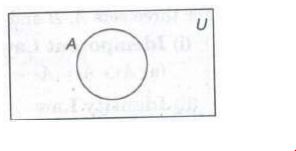
The union of two sets A and B, denoted by A ∪ B is the set of all those elements, each one of which is either in A or in B or both in A and B.
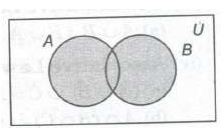
The intersection of two sets A and B, denoted by A ∩ B, is the set of all those elements which are common to both A and B.
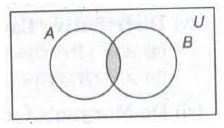
If A1, A2,… , An is a finite family of sets, then their intersection is denoted by
![]()
If A is a set with U as universal set, then complement of a set, denoted by A’ or Ac is the set U – A .
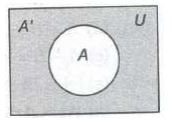
For two sets A and B, the difference A – B is the set of all those elements of A which do not belong to B.
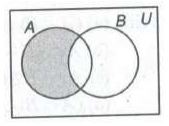
For two sets A and B, symmetric difference is the set (A – B) ∪ (B – A) denoted by A Δ B.
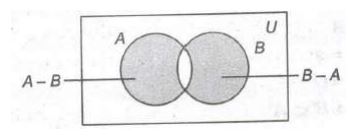
For three sets A, B and C
(i) Commutative Laws
A ∩ B = B ∩ A
A ∪ B = B ∪ A
(ii) Associative Laws
(A ∩ B) ∩ C = A ∩ (B ∩ C)
(A ∪ B) ∪ C = A ∪ (B ∪ C)
(iii) Distributive Laws
A ∩ (B ∪ C) = (A ∩ B) ∪ (A ∩ C)
A ∪ (B ∩ C) = (A ∪ B) ∩ (A ∪ C)
(iv) Idempotent Laws
A ∩ A = A
A ∪ A = A
(v) Identity Laws
A ∪ Φ = A
A ∩ U = A
(vi) De Morgan’s Laws
(a) (A ∩ B) ′ = A ′ ∪ B ′
(b) (A ∪ B) ′ = A ′ ∩ B ′
(c) A – (B ∩ C) = (A – B) ∩ (A- C)
(d) A – (B ∪ C) = (A – B) ∪ ( A – C)
(vii) (a) A – B = A ∩ B’
(b) B – A = B ∩ A’
(c) A – B = A ⇔A ∩ B= (Φ)
(d) (A – B) ∪ B= A ∪ B
(e) (A – B) ∩ B = (Φ)
(f) A ∩ B ⊆ A and A ∩ B ⊆ B
(g) A ∪ (A ∩ B)= A
(h) A ∩ (A ∪ B)= A
(viii) (a) (A – B) ∪ (B – A) = (A ∪ B) – (A ∩ B)
(b) A ∩ (B – C) = (A ∩ B) – (A ∩ C)
(c) A ∩ (B Δ C) = (A ∩ B) A (A ∩ C)
(d) (A ∩ B) ∪ (A – B) = A
(e) A ∪ (B – A) = (A ∪ B)
(ix) (a) U’ = (Φ)
(b) Φ’ = U
(c) (A’ )’ = A
(d) A ∩ A’ = (Φ)
(e) A ∪ A’ = U
(f) A ⊆ B ⇔ B’ ⊆ A’
• Every set is a subset of itself i.e., A ⊆ A, for any set A.
• Empty set Φ is a subset of every set i.e., Φ ⊂ A, for any set A.
• For any set A and its universal set U, A ⊆ U
• If A = Φ, then power set has only one element i.e., n (P(A)) = 1
• Power set of any set is always a non-empty set. Suppose A = {1, 2}, thenP(A) = {{1}, {2},{1,2}, Φ}.(a) A ∉ P(A) (b) {A} ∈ P(A)
• (vii) If a set A has n elements, then P(A) or subset of A has 2n elements.
• (viii) Equal sets are always equivalent but equivalent sets may not be equal. The set {Φ} is not a null set. It is a set containing one element Φ.
Results on Number of Elements in Sets
• n (A ∪ B) = n(A) + (B)- n(A ∩ B)
• n(A ∪ B) = n(A)+ n(B), if A and B are disjoint.
• n(A – B) = n(A) – n(A ∩ B)
• n(A Δ B) = n(A) + n(B)- 2n(A ∩ B)
• n(A ∪ B ∪ C)= n(A)+ n(B)+ n(C)- n(A ∩ B) – n(B ∩ C)- n(A ∩ C)+ n(A ∩ B ∩ C)
• n (number of elements in exactly two of the sets A, B, C) = n(A ∩ B) + n(B ∩ C) + n (C ∩ A)- 3n(A ∩ B ∩ C)
• n (number of elements in exactly one of the sets A, B, C) = n(A) + n(B) + n(C) – 2n(A ∩ B) – 2n(B ∩ C) – 2n(A ∩ C) + 3n(A ∩ B ∩ C)
• n(A’ ∪ B’)= n(A ∩ B)’ = n(U) – n(A ∩ B)
An ordered pair consists of two objects or elements in a given fixed order.
Equality of Ordered Pairs Two ordered pairs (a1, b1) and (a2, b2) are equal iff a1 = a2 and b1 = b2.
For two sets A and B (non-empty sets), the set of all ordered pairs (a, b) such that a ∈ A and b ∈ B is called Cartesian product of the sets A and’ B, denoted by A x B. A x B={(a,b):a ∈ A and b ∈ B}
If there are three sets A, B, C and a ∈ A, be B and c ∈ C, then we form, an ordered triplet (a, b, c). The set of all ordered triplets (a, b, c) is called the cartesian product of these sets A, B and C.
i.e., A x B x C = {(a,b,c):a ∈ A,b ∈ B,c ∈ C}
For three sets A, B and C
• n (A x B)= n(A) n(B)
• A x B = Φ, if either A or B is an empty set.
• A x (B ∪ C)= (A x B) ∪ (A x C)
• A x (B ∩ C) = (A x B) ∩ (A x C)
• A x (B — C)= (A x B) — (A x C)
• (A x B) ∩ (C x D)= (A ∩ C) x (B ∩ D)
• If A ⊆ B and C ⊆ D, then (A x C) ⊂ (B x D)
• If A ⊆ B, then A x A ⊆ (A x B) ∩ (B x A)
• A x B = B x A ⇔ A = B
• If either A or B is an infinite set, then A x B is an infinite set.
• A x (B’ ∪ C’ )’ = (A x B) ∩ (A x C)
• A x (B’ ∩ C’ )’ = (A x B) ∪ (A x C)
2elements in common.
• If ≠ B, then A x B ≠ B x A
• If A = B, then A x B= B x A
• If A ⊆ B, then A x C = B x C for any set C.
If A and B are two non-empty sets, then a relation R from A to B is a subset of A x B.
If R ⊆ A x B and (a, b) ∈ R, then we say that a is related to b by the relation R, written as aRb.
Let R be a relation from a set A to set B. Then, set of all first components or coordinates of the ordered pairs belonging to R is called : the domain of R, while the set of all second components or coordinates = of the ordered pairs belonging to R is called the range of R.
Thus, domain of R = {a : (a , b) ∈ R} and range of R = {b : (a, b) ∈ R}
(i) Void Relation As Φ ⊂ A x A, for any set A, so Φ is a relation on A, called the empty or void relation.
(ii) Universal Relation Since, A x A ⊆ A x A, so A x A is a relation on A, called the universal
relation.
(iii) Identity Relation The relation IA = {(a, a) : a ∈ A} is called the identity relation on A.
(iv) Reflexive Relation A relation R is said to be reflexive relation, if every element of A isrelated to itself.
Thus, (a, a) ∈ R, ∀ a ∈ A = R is reflexive.
(v) Symmetric Relation A relation R is said to be symmetric relation, iff (a, b) ∈ R (b, a) ∈ R,∀ a, b ∈ A
i.e., a R b ⇒ b R a,∀ a, b ∈ A ⇒ R is symmetric.
(vi) Anti-Symmetric Relation A relation R is said to be anti-symmetric relation, iff (a, b) ∈ R and (b, a) ∈ R ⇒ a = b,∀ a, b ∈ A
(vii) Transitive Relation A relation R is said to be transitive relation, iff (a, b) ∈ R and (b, c) ∈ R⇒ (a, c) ∈ R, ∀ a, b, c ∈ A
(viii) Equivalence Relation A relation R is said to be an equivalence relation, if it is simultaneously reflexive, symmetric and transitive on A.
(ix) Partial Order Relation A relation R is said to be a partial order relation, if it is simultaneously reflexive, symmetric and anti-symmetric on A.
(x) Total Order Relation A relation R on a set A is said to be a total order relation on A, if R is a partial order relation on A.
If A and B are two non-empty sets and R be a relation from A to B, such that R = {(a, b) : a ∈ A, b ∈ B}, then the inverse of R, denoted by R-1 , i a relation from B to A and is defined by R-1 = {(b, a) : (a, b) ∈ R}
Let R be equivalence relation in A (≠ Φ). Let a ∈ A.
Then, the equivalence class of a denoted by [a] or {a} is defined as the set of all those points of A which are related to a under the relation R.
Let R and S be two relations from sets A to B and B to C respectively, then we can define relation SoR from A to C such that (a, c) ∈ So R ⇔ ∃ b ∈ B such that (a, b) ∈ R and (b, c) ∈ S.
This relation SoR is called the composition of R and S.
(i) RoS ≠ SoR
(ii) (SoR)-1 = R-1oS-1
known as reversal rule.
Let m be an arbitrary but fixed integer. Two integers a and b are said to be congruence modulo m, if a – b is divisible by m and we write a ≡ b (mod m).
i.e., a ≡ b (mod m) ⇔ a – b is divisible by m.
• If R and S are two equivalence relations on a set A, then R ∩ S is also on ‘equivalence relation on A.
• The union of two equivalence relations on a set is not necessarily an equivalence relation on the set.
• If R is an equivalence relation on a set A, then R-1 is also an equivalence relation on A.
• If a set A has n elements, then number of reflexive relations from A to A is 2n2 – 2
• Let A and B be two non-empty finite sets consisting of m and n elements, respectively.
Then, A x B consists of mn ordered pairs. So, total number of relations from A to B is 2nm.
An operation * on a non-empty set S is said to satisfy the closure ‘ property, if a ∈ S, b ∈ S ⇒ a * b ∈ S, ∀ a, b ∈ S
Also, in this case we say that S is closed for *.
An operation * on a non-empty set S, satisfying the closure property is known as a binary operation. or Let S be a non-empty set. A function f from S x S to S is called a binary operation on S i.e., f :
S x S → S is a binary operation on set S.
Properties
• Generally binary operations are represented by the symbols * , +, … etc., instead of letters figure etc.
• Addition is a binary operation on each one of the sets N, Z, Q, R and C of natural numbers, integers, rationals, real and complex numbers, respectively. While addition on the set S of all irrationals is not a binary operation.
• Multiplication is a binary operation on each one of the sets N, Z, Q, R and C of natural numbers, integers, rationals, real and complex numbers, respectively. While multiplication on the set S of all irrationals is not a binary operation.
• Subtraction is a binary operation on each one of the sets Z, Q, R and C of integers, rationals, real and complex numbers, respectively. While subtraction on the set of natural numbers is not a binary operation.
• Let S be a non-empty set and P(S) be its power set. Then, the union and intersection on P(S) is a binary operation.
• Division is not a binary operation on any of the sets N, Z, Q, R and C. However, it is not a binary operation on the sets of all non-zero rational (real or complex) numbers.
• Exponential operation (a, b) → ab is a binary operation on set N of natural numbers while it is not a binary operation on set Z of integers.
(i) Associative Law A binary operation * on a non-empty set S is said to be associative, if (a * b) * c = a * (b * c), ∀ a, b, c ∈ S.
Let R be the set of real numbers, then addition and multiplication on R satisfies the associative
law.
(ii) Commutative Law A binary operation * on a non-empty set S is said to be commutative, if a * b = b * a, ∀ a, b ∈ S.
Addition and multiplication are commutative binary operations on Z but subtraction not a commutative binary operation, since 2 — 3 ≠ 3— 2 .
Union and intersection are commutative binary operations on the power P(S) of all subsets of set S. But difference of sets is not a commutative binary operation on P(S).
(iii) Distributive Law Let * and o be two binary operations on a non-empty sets. We say that * is distributed over o., if a * (b o c)= (a * b) o (a * c), ∀ a, b, c ∈ S also called (left distribution) and (b o c) * a = (b * a) o (c * a), ∀ a, b, c ∈ S also called (right distribution).
Let R be the set of all real numbers, then multiplication distributes addition on R.
Since, a.(b + c) = a.b + a.c,∀ a, b, c ∈ R.
(iv) Identity Element Let * be a binary operation on a non-empty set S. An element e a S, if it exist such that a * e = e * a = a, ∀ a ∈ S. is called an identity elements of S, with respect to *.
For addition on R, zero is the identity elements in R.
Since, a + 0 = 0 + a = a, ∀ a ∈ R
For multiplication on R, 1 is the identity element in R.
Since, a x 1 =1 x a = a,∀ a ∈ R
Let P (S) be the power set of a non-empty set S. Then, Φ is the identity element for union on P (S) as A ∪ Φ =Φ ∪ A = A, ∀ A ∈ P(S)
Also, S is the identity element for intersection on P(S).
Since, A ∩ S=A ∩ S=A, ∀ A ∈ P(S).
For addition on N the identity element does not exist. But for multiplication on N the idenitity element is 1.
(v) Inverse of an Element Let * be a binary operation on a non-empty set ‘S’ and let ‘e’ be the identity element.
Let a ∈ S. we say that a-1 is invertible, if there exists an element b ∈ S such that a * b = b * a =e Also, in this case, b is called the inverse of a and we write, a-1 = b
Addition on N has no identity element and accordingly N has no invertible element.
Multiplication on N has 1 as the identity element and no element other than 1 is invertible.
Let S be a finite set containing n elements. Then, the total number of binary operations on S in nn2
Let S be a finite set containing n elements. Then, the total number of commutative binary operation on S is n [n(n+1)/2].
Copyright @ ncerthelp.com A free educational website for CBSE, ICSE and UP board.